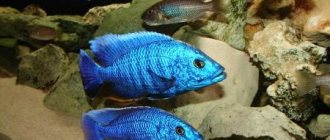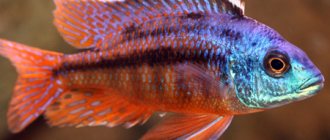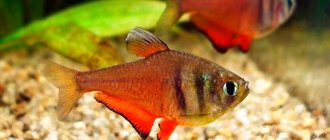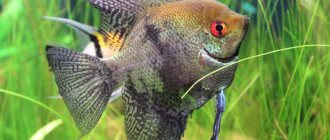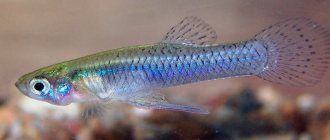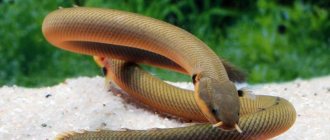Status
This species is listed in the Red Book of the International Union for Conservation of Nature and has the status “VU”, which means “vulnerable”.
Description
Tropheus duboisi is a small fish that appears to have a head that is out of proportion to the body and appears larger than it, with a tapering body that forms a tail.
Adults have a blue to grey-blue head color, and body and fin coloring can vary from bluish-gray to almost black. In addition, adult cichlids have a bright, contrasting stripe down the middle. Juveniles are simply adorable, black and white with bluish polka dots.
The polka dots are subsequently formed into vertical stripes. Young Tropheus duboisi. The change in color of the fry as they grow up is an amazing phenomenon. As they get older, the black coloring disappears and stripes begin to appear around the body of the fish, and the yellow or white coloring also gradually disappears.
Gradually, the spots on the body disappear, and the heads of the fish begin to acquire a bluish tint, although some spots remain a little longer. The spots on the body begin to form in irregular stripes, and then, when the fish become adults, they acquire a distinct color.
Characteristics
The first thing that catches your eye when meeting a fish is its bright coloring. What is surprising: the color of the scales changes with age.
In young tropheus, the entire body, including the head, is painted a rich black color. In this case, white or bluish round spots of varying diameters are located throughout the body.
As they grow older, the color changes dramatically, which is a characteristic feature of this particular species of Tanganyika cichlids.
The head of an adult (both males and females) is painted bright blue or blue, the body and tail are dark blue or black, and a bright wide yellow stripe runs across the body, which clearly contrasts with the dominant color of the scales.
Sometimes there may be several of these stripes, but then the width of each of them is much smaller.
It seems that young tropheus and adult individuals are completely different species of cichlids. This is precisely what attracts aquarists around the world to breeding and keeping these exotic fish; it is precisely this feature that allowed the star-shaped “Africans” to become a bestseller in Europe and America 40 years ago.
FEEDING. These aquarium cichlids are omnivores by nature. Under natural conditions, they feed on microorganisms and algae that they scrape from rocks. Therefore, in the aquarium, in addition to animal food (daphnia, brine shrimp), they must be fed with plant food for fish (regular spirulina in the form of granules and flakes is suitable).
It is recommended to avoid protein in the form of tubifex, beef heart, mosquito larvae, and sea shrimp meat - there is an opinion that this particular diet provokes bloating. Although some experienced aquarists say that these types of food can also be used.
The main thing is to accustom tropheus to them very gradually and give food three times a day in small portions, and not once and in large quantities. Before adding granulated food to the aquarium, soak it in water so that it does not cause excessive gas formation by swelling in the intestines.
TECHNICAL TIPS. Star tropheus are peaceful aquarium fish, but you should not hope for their compatibility with other cichlids. It is recommended to keep these fish in a species aquarium. For example: a group of one male and 4-6 females, for which an aquarium of 100 liters or more with sandy soil, shelters made of large stones and hard-leaved plants is suitable. It is not advisable to add newcomers to a group where hierarchical relationships have already been established - the new fish will most likely be beaten to death.
Aeration and filtration are required. Water changes must be made twice a week, 15% of the total volume (Lake Tanganyika cichlids do not tolerate large amounts of organic matter in the water).
REPRODUCTION. These are easy to keep aquarium cichlids; breeding them in captivity also does not present any difficulties. They become sexually mature at ten to fourteen months; the separated pair is not required to be deposited into the spawning area. More frequent water changes can be used as stimulation. The male digs a hole in the ground, the female lays from one to five eggs into this hole, either onto the walls of the aquarium or a flat stone.
Then it collects the eggs in its mouth and moves towards the male, who secretes milk. After repeating these steps several times (until the number of eggs reaches about thirty), the female, with eggs in her mouth, takes refuge in her favorite cave. The larvae and then the grown fry will stay in the mother’s mouth for three to four weeks, going out for a “walk” more and more often and for a longer period of time. Then for some time the female actively protects the offspring. Traditional “live dust” will be an excellent starting food for juveniles.
Spreading
Stellate tropheus was first described in 1959 by scientist G. Marlier. The distribution of this fish species is limited to Lake Tanganyika, located in Africa. It lives in the northern part of the lake in the area of rocks, feeds on algal fouling, microorganisms, and uses caves as shelters. The fish are closely related to the “Blunt-headed cichlid” Tropheus moorii, but live at greater depths and have different behavior.
Unlike other Tropheus species, they do not tend to stay in groups, but rather swim alone or in pairs at depths of 3-15 meters. There are four types of geographical variations of Tropheus duboisi, each of which, although slightly, is still distinguished by a stripe located in the middle part of the body and bordering it: Tropheus stellata reaches a length of approximately 12 cm.
Social behavior of fish
Tropheus stellata is an aggressive species of cichlid. These fish are not always ready to “play with other fish” and the ideal option would be to keep them in a separate aquarium. They are said to be less aggressive than their counterparts, but behavior varies from individual to individual. These fish should be kept in groups (communities) of 10 individuals or more, including one male.
If there are two males, then the group should consist of 15-20 individuals and the volume of the aquarium will need much more. A large number of females is necessary to evenly distribute the aggression of males. Do not add several new fish to an already established colony, as this may upset the fish and cause their death.
The fish can be kept in a large aquarium with rock-dwelling herbivores, African cichlids, some varieties of sardine cichlids, Cyprichromis leptosoma, which are known to have a calming effect on aggressive cichlids, and the feathery catfish Synodontis. Do not house cichlids with slow-swimming fish or predators.
By adding nimble fish to the aquarium, for example, iris, you can divert the aggression of males from females. A large aquarium volume and a sufficient number of shelters (except during the breeding season) will also help to cope with aggressive behavior. If fish are in the breeding season, they should not be housed together with Plextomus, because these fish are capable of eating fry at night. Tropheus are omnivorous fish and will eat anything that comes into the aquarium.
They rarely allow food to sink to the bottom. However, if you give trophies more food than they need, or food that is not specific to them, then the fish will overeat, which will ultimately lead to bloating.
Sex differences
Determining the sex of Tropheus duboisi poses certain difficulties. Males are slightly larger than females, but this is not always the case. Males tend to have a dark body and a more upturned nose. Females do not grow as quickly as males, and their colors are less saturated.
Description
Star Tropheus is a robust fish that has a large head in proportion to its body, and the body tapers to form a tail. The tail fin is shaped like a propeller blade.
Adult fish have a bluish-blue head with an almost black body and fins, and a bright contrasting stripe in the center. Teenagers are very attractive - with a black body covered with bluish-white spots.
The change in color between young fish and adult fish is truly impressive. As it grows, a streak like faded yellow or white color begins to appear. Gradually the spots on his body disappear and his head begins to turn blue, although he still has spots. The spots on the body begin to form into irregular stripes, which then also fade to a solid color as the fish mature.
Size
Maximum standard length 12 cm.
Aquarium water quality
This is a very important condition for keeping a flock of handsome starfish, since under natural conditions they live in lake water with stable parameters and are very sensitive to even minor deviations from the norm. In principle, this is the main difficulty in keeping these cichlids.
It should be noted that the water in Tanganyika is clean, hard and slightly alkaline. This is exactly the chemical composition that needs to be maintained in the cichlid fish. So, the main parameters of water:
- hardness from 10 to 20 degrees (it can be maintained at this level using limestone or marble);
- temperature not lower than +25° and not higher than +27°;
- acid-base balance 7.5–8.5 (slight shift towards alkalinity).
To control parameters, many aquarists draw up graphs where they record the results of testing water quality using special tests.
It should be borne in mind that even the most insignificant or sharp deviation from these parameters is undesirable. For example, a decrease in water temperature by only 2-3 degrees leads to a cold, and then to the death of fish.
The purity of the water must be maintained at all times. Therefore, a reliable high-capacity filter is needed (due to the size of the aquarium), and powerful biological filtration must be required: cichlids do not tolerate excessive doses of nitrates and nitrites at all.
Water changes to reduce the concentration of nitrogenous compounds should be carried out weekly and very carefully. The maximum amount of water replaced is 15% of the total volume.
In Tanganyika, lake water is highly saturated with oxygen, which means that constant intensive aeration is necessary in the aquarium.
Diseases
Tropheus are relatively hardy if care is taken to maintain favorable environmental conditions and diet. These fish are susceptible to common diseases, especially if the water is old, of poor quality and has low oxygenation.
The most common disease of the species is white spot disease, which manifests itself as white rashes on the body of the fish. To fix the problem, change the water and increase the temperature in the aquarium to 30℃ for 3 days.
Behavior in natural conditions
Graceful representatives of cichlids were described and studied in detail relatively recently, in the 40s of the last century. The credit goes to the famous ichthyologist Dr. M. J. Marlier, who at that time headed the scientific station for studying the fauna of the African Lake Tanganyika. He also identified and classified several species of the genus Tropheus, including the star-shaped one or Tropheus duboisi.
The distribution area of these fish is very narrow - the coastal waters of Lake Tanganyika. They are no longer found in any other place on the globe. Therefore, Tropheus duboisi is a typical endemic.
The behavior of star tropheus has its own characteristics, which must be taken into account when kept in aquarium conditions.
Living conditions . Tropheuses have an active lifestyle. They live in the upper layers of lake water at a depth of no more than 15 meters, near rocky shores. Why there? The fact is that the main food of tropheus is rock algae, which they scrape from stone surfaces due to the specific structure of the jaws and throat. For a long time they were considered exclusively herbivores, until it was noticed that along with algae, fish also happily eat zooplankton.
In the wild, fish do not form large schools; most often you can find (if you're lucky) a stable pair of them.
Territoriality . These Tanganyika cichlids cannot be called aggressive. In nature, there are also more dangerous representatives of the family, but this applies to each individual separately. If a stranger invades the space where a pair or a small flock of Tropheus lives, he will not be happy.
Interestingly, it is the male who drives away the trespasser. This allowed experts to conclude that in this case we are not talking about a dispute over territory, but about eliminating a potential rival.
Population . Due to its small size and its habitat in the upper layers of lake water, Tropheus duboisi is not a commercial fish. Despite this, the population of Tropheus stellata is relatively small, which was facilitated by their wild popularity among Western aquarists in the last third of the twentieth century. This circumstance has led to the fact that, according to the international classification, this species of Tanganyika cichlids is assigned the status “VU”, i.e. “vulnerable”.
Compatibility . If Tropheus duboisi is planned to be kept in a community aquarium, then its neighbors may be other Tanganyika herbivorous cichlids and some species of catfish (for example, synodontis). A funny practice: to reduce the aggressiveness of males towards their relatives, a fast-moving neon iris is added to a common aquarium. She often successfully distracts the male star, who cannot catch up with her. And besides this, the iris noticeably decorates the interior space with its very presence.
Range and Habitat
Africa, Lake Tanganyika, northern part.
The species is endemic to this lake. They live in rocky coastal areas at depths of up to 30 m. In nature, adult males do not occupy a permanent territory. Most T. duboisi live in small groups or alone. They move around habitats in search of food. Their diet consists mainly of algae, more precisely of biomass that grows on stones, it can contain insect larvae, crustaceans, snails and zooplankton. Because T. duboisi is found at slightly deeper levels of the lake, between 7 and 25 meters, the algae beds are not very thick and so the fish must constantly move around to get enough food.
Four subpopulations are recognized in different parts of the lake and are commonly referred to as Tropheus Duboisi or Tropheus Stellata. But they are also called by their place of origin along with the corresponding name, and their difference is the color (white or yellow) and the width of the vertical stripe, which is present in adult fish.
Tropheus Duboisi "Maswa" (T. duboisi Maswa) - This subpopulation is known as the yellow broadstriped and originates from the Kalemie port area, Congo.
Tropheus Duboisi "Kigoma" (T. duboisi Kigoma) - This subpopulation is the largest, has a wide stripe of white color, but not as wide as the Bemba, comes from the Malagaria region of Tanzania on the border with Burundi.
Tropheus Duboisi "Karilani" (T. duboisi Karilani) - a subpopulation known as narrow-banded, has a narrow white stripe, caught in the area of Karilani Island, Magambo.
Tropheus Duboisi "Bemba" (T. duboisi Bemba) - This subpopulation is known as broadband, has a wide white stripe, and comes from a portion along the lakeshore in the Bemba region of Congo.
The Maswa population is perhaps the most popular in the aquarium hobby because its yellow stripe is particularly wide. Males and females have the same coloration.
Content Features
Three decades ago, the conditions for keeping tropheus were considered very difficult. This was due to poor knowledge of their behavior in captivity. Gradually, practice and observations of the lifestyle of these cichlids developed very specific requirements for maintenance, feeding and breeding.
The best and safest option is a separate aquarium for one species, i.e. cichlid fish.
Star-shaped “Africans” are best kept in a group of 10–12 individuals. Of course, this requires a fairly large home pond with a capacity of at least 200 liters. In general, in this case the rule applies: the larger the aquarium, the better.
A group of fry is released into the aquarium and, as they grow, males are removed. Let us remind you: there should be only 1 male leader in a pack.
Since the sexual characteristics of individuals are very poorly developed, the presence of two or more males is determined by their behavior: if the fish show increased aggression towards each other, then these are males.
Many aquarists keep large flocks (from 20 to 25 individuals) of star tropheus, or more precisely, 2-3 flocks, each of which is headed by a male. Looks very impressive! However, the aquarium should be much larger, about 300 liters.
There are specific recommendations for equipping an aquarium. In order to create conditions close to natural, the aquarium biotope must contain grottoes, caves, slides, and stone arches. There should be at least 1 more such shelters than the number of fish. There may be very little aquatic vegetation.
There are no specific requirements for the soil substrate: it can be river sand or small river pebbles. In our case, the soil plays more of an aesthetic role, so it can be selected in accordance with the overall composition of the aquadesign.
As for lighting, its intensity should promote the growth of algae, which the herbivorous Tanganyika cichlids eat. There are no other requirements.
Compatibility with other fish
Compatible
Tropheus are aggressive cichlids. Therefore, it is important to know Tropheus stellata’s compatibility with other fish in the aquarium. They are less aggressive than other cichlid fish, but this can vary depending on the personality of the individual fish. There is evidence that species such as sardines, Cyprichromis leptosoma and species of the genus Eremodus may have a calming effect on aggressive cichlases.
Not compatible
Do not keep cichlases with small peaceful aquarium fish, as they will be eaten by trophaeus starfish.
Recommended feeding
Tropheus duboisi is a herbivorous cichlid. According to the recommendations of experts, the main diet should include chopped leaves of spinach, nettle, lettuce, and dandelion. You can give pureed vegetables - carrots, zucchini, cucumbers. Some branded foods are also suitable, such as Sera Spirulina Tabs and Neon Vegetable Diet.
Since in nature tropheus also eat zooplankton, the feeding diet includes animal food: daphnia and artemia, as well as commercial food for cichlids - Tetra Cichlid or Neon Cichlid Mix. However, animal food can only be used as a supplement to plant food.
It is recommended to feed twice a day, morning and evening. It must be taken into account that fish have long intestines, so food is digested slowly. So it is better to underfeed them a little rather than overfeed them.
Breeding
Ancistrus reproduce quite easily in an aquarium, the conditions are the same as for the common ancistrus. Fish become sexually mature at the age of 8-12 months.
In nature, spawning occurs in winter. In the Amazon, the rainy season begins, which is characterized by a large influx of cool water. The trigger for the start of spawning is the replacement of a large amount of water - up to 75% and a decrease in temperature. The same conditions are created in nature during the rainy season.
One amateur obtained fry at a water temperature of 18 degrees Celsius, although he did not repeat this experiment again, this is still extremely low.
The spawning tank should have a volume of at least 40 liters, with plenty of shelters and snags. Recommended water parameters are acidity 6.5-7.0 pH and hardness 5-10 degrees.
The male carefully cleans the shelter he has chosen and then invites the female for inspection. In the shelter, the female lays from 20 to 200 eggs. Usually they are located on the walls.
As soon as the female has laid eggs, she must be removed immediately; she does not show any further participation and only irritates the male. He is very caring and will spend the next 7-10 days in the care of the eggs, constantly fanning them with his pectoral fins, removing dead eggs and protecting them.
As a rule, he doesn’t even eat during this period, so don’t be alarmed.
After 7-10 days, larvae will appear, which are attached to the walls and feed from a large yolk sac. Once the larva consumes it completely, it will turn into a small copy of its parents.
From this time on, the male can be removed and the fry can be fed. Food for shrimp, food for ancistrus and artemia nauplii are the basis of the diet.
What to feed tropheus?
In general, star tropheus eat almost everything, but in natural conditions they most often eat particles of algae that are mined on rocks, and also eat various plankton from plants or marine life. At home, tropheus should be fed mainly only plant-based foods. Special preparations for cichlids living in Africa are perfect for this purpose. This diet contains a lot of fiber, as well as spirulina.
In addition, tropheus can be fed with pieces of various vegetables; in this case, zucchini, lettuce and cucumber are suitable. In addition to plant-based foods, live foods can be added. Tropheus are excellent eaters of daphnia, brine shrimp and gammarus. It is better not to feed representatives of this species with bloodworms or tubifex, since such food can cause digestive problems in fish.
You should not give a lot of food at a time to such fish, since they have a peculiarity - a rather long digestive tract. Overfeeding can lead to digestive difficulties. It is best to feed tropheus approximately 2-3 times a day in small portions.
conclusions
To successfully keep tropheus in an aquarium, it is necessary: 1) Maintain the temperature within the specified range of 26-28 ° C 2) Create effective filtration and aeration 3) Do not overfeed the fish 4) Change weekly from 10% to 30% of the water. 5) Regularly test the water for the presence of nitrates (this indicator should not be more than 25 ppm) 6) Maintain acidity (less than 7 is not allowed) and hardness (total and carbonate) at the proper level.
In aquariums, Tropheus live up to 10 years and during this time retain the ability to reproduce.
Believe me, a large aquarium with a rocky landscape inhabited by a group of tropheus is an unforgettable sight.
Appearance
The body shape is like that of a typical African cichlid fish. Tropheus stellate has a dense and low body, but a large head. The average size of aquarium tropheus is about 10 cm, although larger specimens are found in the lake. The color of the scales of adults and young animals is different. Males are slightly larger and brighter than females, although the difference between them is difficult to discern.
The diet is varied; in the wild they eat algae and microorganisms (phytoplankton, zooplankton). In an aquarium, you can give plant food, which is sold in pet stores as food for cichlids. Fiber and spirulina are essential. They can eat slices of cucumber, zucchini and lettuce. Daphnia, artemia, and gammarus are suitable as live food. To avoid diseases of the gastrointestinal tract, bloodworms and tubifex should not be given.
Thanks to the long digestive tract, Tropheus stellata limits itself in nutrition. Feeding 2-3 times a day in small quantities will keep the fish healthy.
Conditions of detention
It can be kept in a large aquarium with a volume of 200-300 liters. For one male you should have six females. Tropheus starfish is a fish with character, so the male will defend his territory from competitors. If there is more than one dominant in the reservoir, they will begin to sort things out. To avoid conflicts, it is better to build enough shelters in the aquarium.
Watch a short video about the care and maintenance of Tropheus stellata.
You can line the bottom of the nursery with sand; it is recommended to place driftwood, coconuts and stones as decorations and shelters. Bright lighting will speed up the growth of algae on the stone. Of course, cichlids will eat plants. Hard-leaved species like Anubias are also suitable.
Water conditions:
- Clean water low in nitrates and ammonia;
- High oxygen content;
- Powerful water filtration, bottom siphon;
- Renew 20% of the water with fresh water once a week;
- Water temperature 25-28 degrees, hardness 10-12dGH, acidity – 8.5-9.0 pH.
Stellate tropheus are complex fish. Aggressive towards peaceful neighbors. Suitable for keeping in a general nursery either with cichlids or independently. It is better to purchase at least 6 females for one male, but it is worth raising them from an early age - they do not get used to new fish well, for which they may suffer. The only ones with whom they get along (according to observations) are neon iris and synodontis, although it is better to avoid cohabitation.
Check out the pair of star-shaped trophaeuses.
How to breed
Before breeding, you should know that Tropheus stellata is a spawn-laying cichlid that reproduces well in the same aquarium where it lives. Up to 10 females live with one male, but a permanent flock is not formed immediately, but almost from childhood. Many females calm the temperament of the male, who is prone to stalking and aggression. Males are ready to spawn at any time of the year, while females require preparation. If one female cannot have offspring, the other will agree to this.
Before spawning, the male prepares a nest where the female will lay eggs (up to 30 eggs). After spawning, the female takes it into her mouth, and the male fertilizes the eggs. Gestation lasts about a month, after which large fry appear. During gestation, the female feeds carefully, without eating the eggs. Starter food for fry is brine shrimp and spirulina. After the offspring appear, they can be separated from their parents in a separate aquarium.
